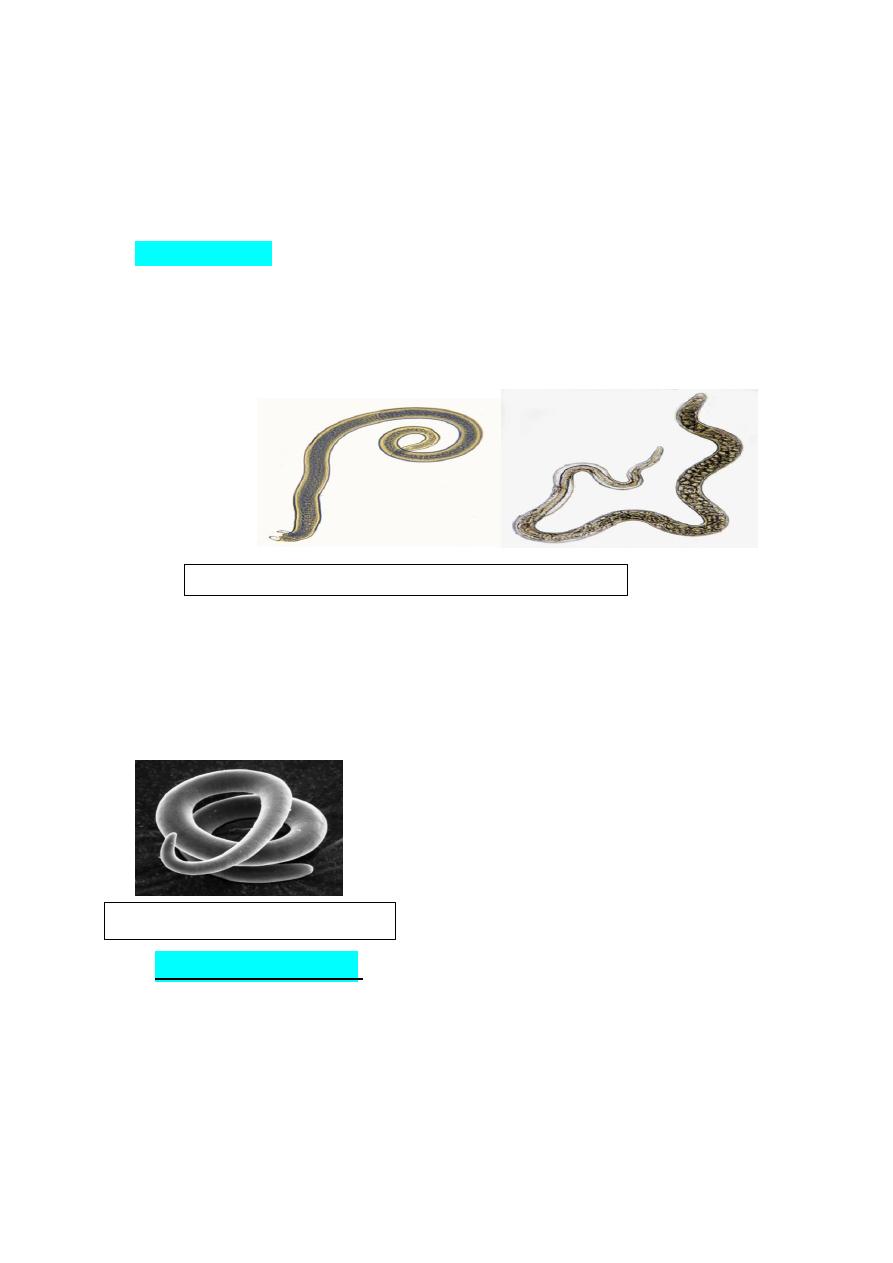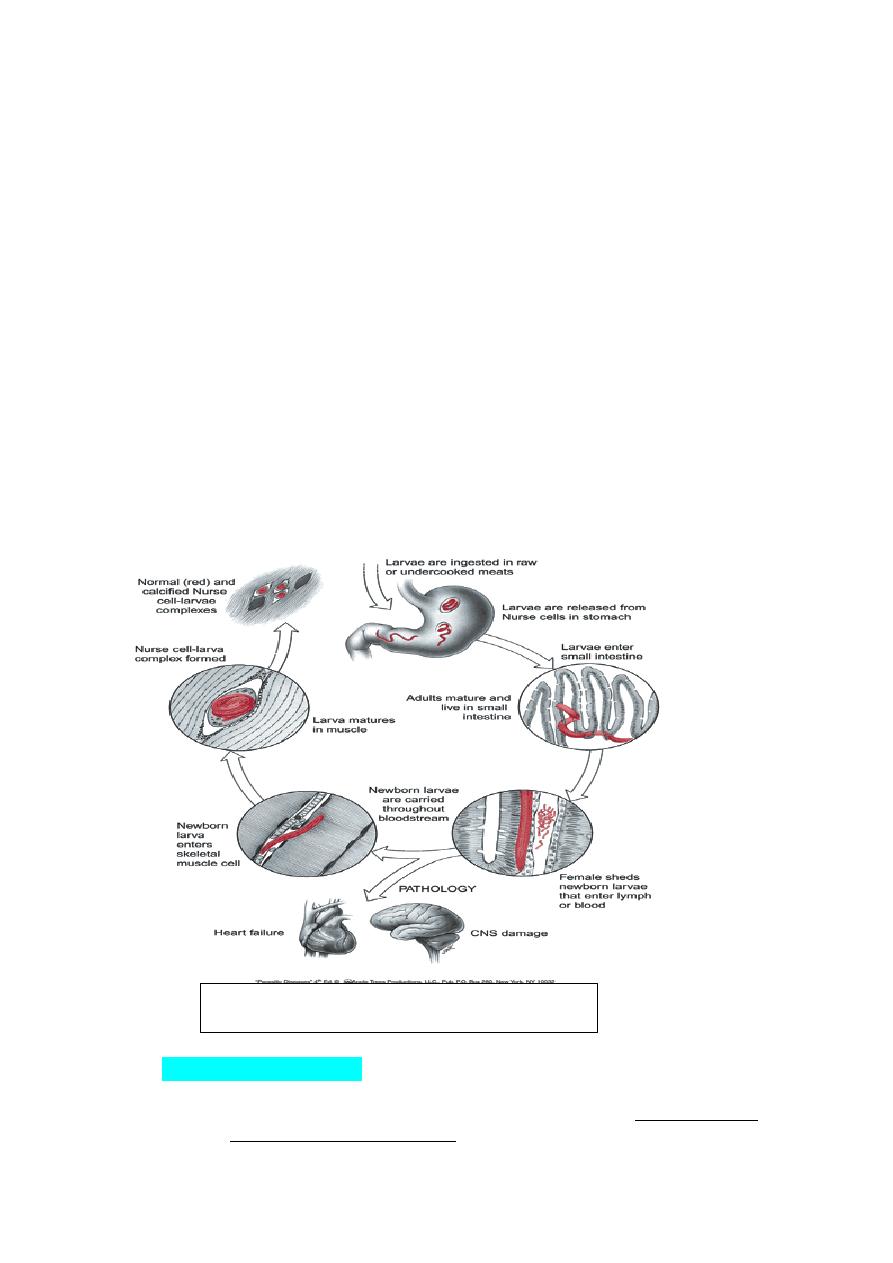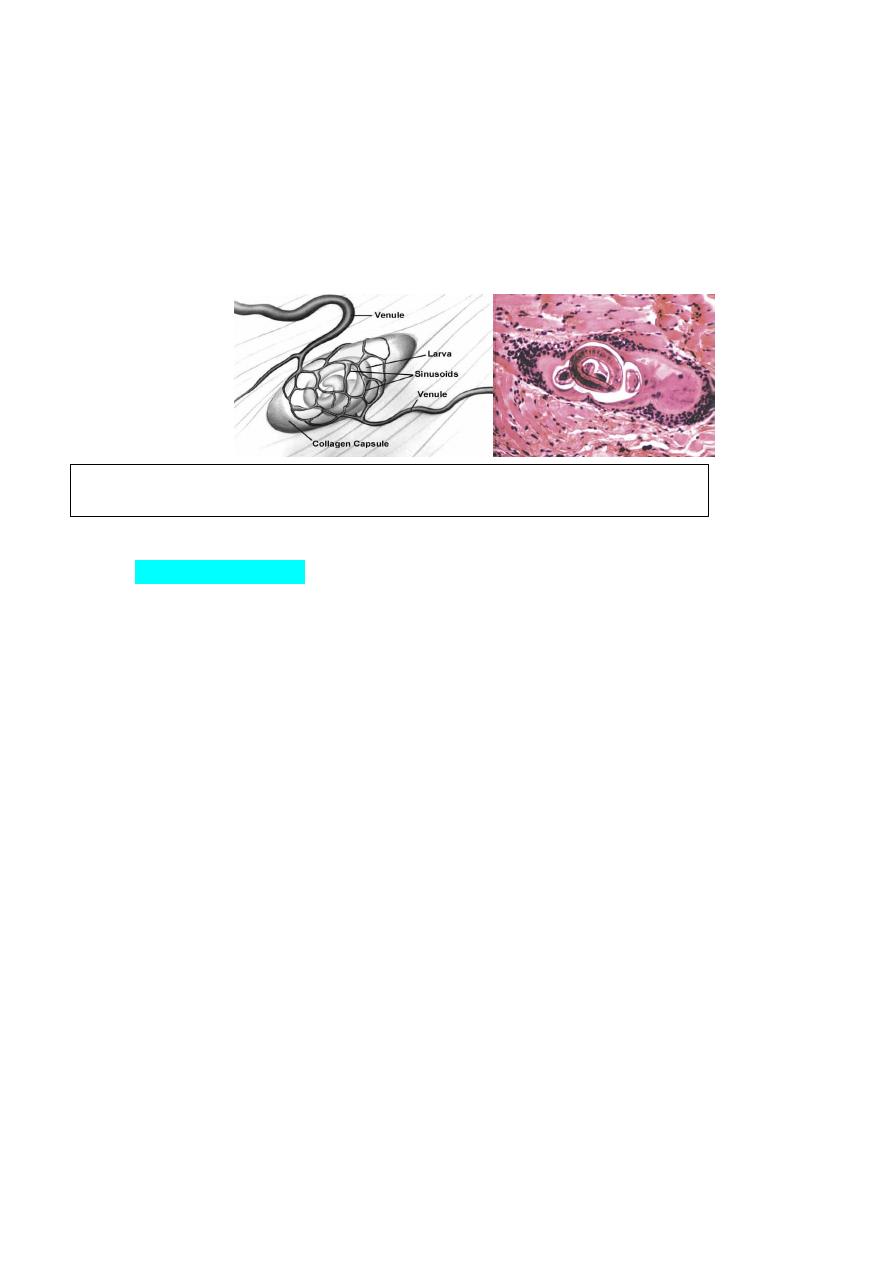
1
Trichinella spiralis
:
The aim of study T.spiralis:
Trichinellosis, is normally not included among those
regarded as emerging zoonosis, because it has been a public health threat for more
than 150 years
,since the infective encysted larvae may remain viable in the host’s
musculature for many years; a can be fatal when they may also survive long periods
in decaying and putrefying muscle.
The Objectives
:
1.Define T.spiralis.
2.Describe the Epidemiology.
3.Describe the morphology.
4.Analyse the life cycle.
5.Nurse cell formation.
6.Determine the clinical features
7.List the laboratory diagnosis.
8. Predict the prevention and control.
1.T.spiralis:
Trichinella spiralis is a nematode parasite of humans that is
cosmopolitan in its geographical distribution. It is nearly unique among
helminthic parasites in that all stages of development occur within a
single host; over 100 species of mammals have been reported to be
susceptible to infection.
•
Trichinella spiralis is capable of infecting all mammals, cause
parasitic zoonosis—trichinellosis.Human beings acquire the food-borne
trichinellosis by ingesting the raw or undercooked meat of pigs and
other animals containing the Trichinella larvae,Larvae which inhabit the
striated skeletal muscles are the main pathogenic stage . The adult worm
of T.spiralis is the smallest nematodes which infects man.
•
• 2.Epidemiology: The global prevalence of trichinellosis is estimated as many as 11
million people may be infected. More cases of human infection have been found in
developed countries than in developing countries.
This species is significantly higher
in prevalence in people living in certain parts of
Europe, Asia, and Southeast Asia

2
than in the United States
. It is now considered endemic in Japan and China. A large
outbreak of trichinellosis occurred in Lebanon in 1997.
• Mode of infection: Ingesting the raw or improperly prepared pork products
Habitat: The adult worm inhabit the small intestine of pig , rat and man.
3.
Morphology:
A. Adult worm: It is minute, whitish, thread like ,both male and female
worms are wider posteriorly than anteriorly. female worm is approximately twice as
long as male,the female is ovoviviparous which producing eggs after fertilization that
are immediately developed into larvae in the uterus and then passed in the stools.
The male is shorter than female and the anterior end is delicate and filariform while
posterior end bears two conspicuous conical papillae .
2.Larvae : These are released in the intestine,from where they are carried
by systemic circulation and are deposite in various organs
and tissues of the
body. The larvae becomes encysted in the striated muscles, and are infective
to other hosts. The larva in the cyst is coiled and hence the name spiralis in
species.
4.Life Cycle
T.spiralis:
The life cycle either: Sylvatic cycle or domestic cycle.
Sylvatic cycle: occur Pigs when they eat infectious cysts in raw meat, often pork or
rats . While domestic cycle occurs when humans eat raw or undercooked infected
pork. After humans ingest the cysts from infected undercooked meat, pepsin and
hydrochloric acid help free the larvae in the cysts in the stomach. All stages of
development occur within a single host such as humans, pigs, dogs, rats and cats.
Male and female of T.spiralis
Infective first stage larva of
Trichinella spiralis

3
Adult worms reside in small intestine, and larvae reside in skeletal muscle. However,
two different hosts are required to complete the life cycle.
Primary host
:
The pig is the primary host.
Natural host: rodents, carnivores and various other species of omnivorous
animals are other natural hosts.
Man is an accidental host and is the dead end for the parasite.When man consumes
raw or rare flesh infected with cysts of Trichinella, the cysts are digested out of the
muscle in the stomach; the larvae (first stage)are resistant to gastric juice. After
passing to the small intestine, the larvae penetrate the villi of the small intestine, molt,
and develop into mature adult within 48 hours. After fertilization, the gravid female
burrow deep into the mucosa, discharging larvae beginning 5 to 46 days after
infection and continuing for 2 to 4 weeks or occasionally longer. Widely disseminated
via lymphatics and the bloodstream, larvae enter most organs, but persist only in
individual skeletal muscle fibers. The larval host cell becomes a nurse cell in which
the larvae will be encapsulated. The development of a capillary network around the
nurse cell completes encystation of the larvae.Although the capsules calcify within six
months to two years, the larvae within remain viable for months to years, rarely for
decades.
5.Nurse cell formation:
•
The Nurse cell is a unique consequence of the host cell’s association
with the infectious L1 larva of Trichinella spiralis and other Nurse cell-
forming species of Trichinella (T. britovi, T. nelsoni, and T.nativa). It
Life cycle of T.spiralis

4
presumably functions to nourish it as well as protect it from host immune
responses. The mature Nurse cell is morphologically distinct from any
other mammalian cell type; no other pathological condition induces such
a radically different, and yet functional cell. The Nurse cell-parasite
complex can survive in the human host for up to 30 years, and in most
other species of mammal for the life span of the animal. For this to
occur, the worm must immuno-suppress the host, yet nothing is known
regarding the mechanism(s) employed by the parasite through
which it keeps the host from killing it.
•
6.Clinical features:
The great majority of trichinosis infections have either minor or no
symptoms and no complications. There are two main phases for the
infection: enteral (affecting the intestines) and parenteral (outside the
intestines). The symptoms vary depending on the phase, species of
Trichinella, amount of encysted larvae ingested, age, gender, and host
immunity.
Enteral phase :
A large burden of adult worms in the intestines promote
symptoms such as nausea, heartburn, dyspepsia, and diarrhea from two to
seven days after infection, while small worm burdens generally are
asymptomatic. Eosinophilia presents early and increases rapidly.
Parenteral phase
: The severity of symptoms caused by larval
migration from the intestines depends on the number of larvae produced. As
the larvae migrate through tissue and vessels, the body's inflammatory
response results in edema, muscle pain, fever, and weakness. A classic sign
of trichinosis is periorbital edema, swelling around the eyes, which may be
caused by vasculitis. Splinter hemorrhage in the nails is also a common
symptom. The most dangerous case is worms entering the central nervous system
(CNS). They cannot survive there, but they may cause enough damage to
produce serious neurological deficits (such as ataxia or respiratory paralysis), and
even death. The CNS is compromised by trichinosis in 10-24% of reported cases of a
rare form of stroke.
[10]
Trichinosis can be fatal depending on the severity of the
infection; death can occur 4–6 weeks after the infection, death can occur 4–6 weeks
after the infection, and is usually caused by myocarditis, encephalitis, or pneumonia.
Infective first stage larva of Trichinella spiralis in its Nurse cell in muscle tissue. The
worm measures 1mm x 36 µm.

5
7.Diagnosis :
Muscle biopsy is used for trichinosis detection. Several immunodiagnostic
tests are also available. In pigs, ELISA testing is possible as a method of
diagnosis. Anthelmintics can treat and prevent Trichinella infections
A correct diagnosis depend upon demonstration of Trichinella in the muscle
either biopsy or autopsy.Various tests useful in diagnosis:
1.DLC:shows marked eosinophelia up to 50 .
2.X-Rays examination :may show the presence of calcified cysts in the
muscles.
3.Increased levels of muscles enzymes:such as lactate dehydrogenase
,creatine phosphokinase due to muscles invasion .
4.muscles biopsy: This is the best way to demonstrate the presence the larvae.
8.Prevention and control
:
Freezing meat in an average household freezer for 20 days before consumption will kill
some species of Trichinella. Cooking Pork products to a minimum internal temperature of
160°F will kill most species of Trichinella and is the best way to ensure the meat is safe to
eat.
